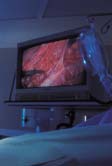 Making
Surgery Safer Minimally invasive surgery usually has fewer complications than traditional open surgery and since the invention of fiber optics in the 1950s, doctors have tried to replace conventional surgery with minimally invasive equivalents. Minimally invasive surgery is used to do everything from fix torn knee cartilage to remove damaged gall bladders. It's a little trickier with cancer surgery; surgeons need to not only remove the diseased organ but also a layer of tissue around the organ, known as the margin, to make sure they have gotten every cancer cell. Dr. Ninh T. Nguyen, now an assistant professor of surgery at UC Davis Medical Center, was part of a team of physicians at the University of Pittsburgh Medical Center who in 1996 developed laparoscopic esopha- gectomy as an alternative to conventional esophagectomy. In an esophagectomy, surgeons remove all but the upper part of the esophagus. Next, they pull the stomach up from the abdomen and stretch the neck of the stomach to re-establish a continuous gastrointestinal tract. About five percent of patients perish from side effects of the surgery, according to Nguyen, and the number is higher at hospitals whose surgeons do not perform at least six esophagectomies a year.
Home |
Table of Contents |
To our Readers |
Building on Basics UC Davis Health System | © 2000, 2001, 2002 UC Regents. All rights reserved. |
Laparoscopic surgery is sometimes called 'keyhole surgery' because physicians like Ninh Nguyen must manipulate flexible instruments through tiny incisions while watching an image of the patient's body on a video monitor. |

